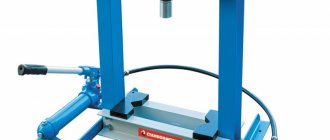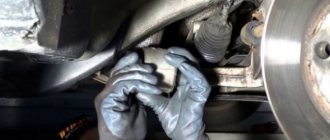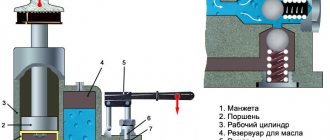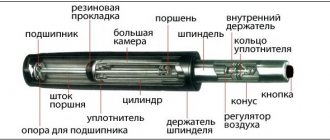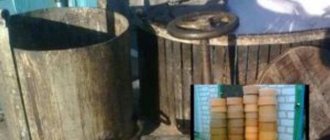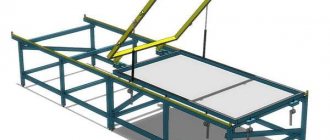As practice shows, home-made parts for cars and other do-it-yourself devices are in many ways not inferior to factory-assembled ones, and in some cases even surpass them.
Dear reader, today we want to take you through the design of a homemade press made from a jack. As practice shows, its assembly at home can guarantee its owner reliability and a long time of trouble-free operation.
Purpose and scope of use of a hydraulic press
A hydraulic press is a device that exerts great pressure on the material being processed through little effort. This operating principle is based on Pascal's law, according to which the applied force acting on a certain area is transmitted throughout the entire volume and is equal in all directions.
The hydraulic press is used for stamping, pressing, extrusion, assembly, forging, bending
The hydraulic press device consists of two cylinders. When exposed to a smaller chamber, the pressure of the liquid in it increases, which is transmitted through a special channel to the larger chamber. The working fluid exerts pressure on the piston, which contributes to the effect of the element on the workpiece. Cylinders are usually located vertically, but there are also options that have horizontal placement. A special oil is used as the working fluid.
The installation is used for pressing, stamping, extrusion, assembly, forging, bending, and straightening of metal elements. You can buy or make your own cardboard press, which will be indispensable for packaging, briquetting, pressing and recycling materials made of plastic, paper and rubber. The equipment is characterized by versatility and can be used in different areas of life for repair, maintenance and preventive maintenance. Depending on this, the press has a certain design.
Options for using a hydraulic press at home
To squeeze metal elements out of the shell or base, you can buy or make a hydraulic press with your own hands for the garage. The equipment is also suitable for pressing out bearings and silent blocks that cannot be mounted and dismantled manually. Using such a device, you can straighten, join two elements, and bend a metal workpiece.
Helpful advice! When making a press with your own hands, you need to decide on the further purpose of the device, its dimensions, piston performance, weight and the possibility of installing a pressure gauge.
When manufacturing a hydraulic press for a garage, it is necessary to take into account the dimensions of the vehicle being serviced.
When creating a hydraulic press for a garage, you should take into account the size of the car. For passenger vehicles, it is enough to make a simple design, but for large vehicles it is better to make a more complex and larger unit.
The device is often used as a waste paper press. With your own hands you can make good fuel for the stove from old paper. For such purposes, it is enough to make a simple design with an average power rating, which will allow you to recycle a large amount of waste paper.
The equipment is also suitable for pressing sawdust. Such briquettes are good fuel for stove heating; they burn for a long time without producing smoke, creating intense heat. Instead of sawdust, coal chips are also suitable as a filler for the press. Such a unit will consist of a work table, a base, a power frame and a drive.
A good result is ensured by a self-created press for PET bottles, which turns the container into neat layers. The hydraulic tool can be used as a hay picker. In this case, the design is complemented by a frame frame made of timber or metal without an upper part. The element is fixed to the front using special fasteners. You will also need a transport pick-up and running gear.
Hydraulic press is also used for squeezing juice from fruits.
Homemade jack for raising a car: drawings and description of how to make
A jack is a device that no driver can do without when repairing their car. It is needed to lift loads to a small height. It should be stored in the trunk of a car or in a garage.
When purchasing such a device, you need to pay attention to the load capacity, which should be as high as possible, as well as the universal functionality. Many car enthusiasts prefer a hydraulic jack, which you can build with your own hands.
But before that, you need to study information on how to make a homemade car jack with your own hands at home.
Types of jacks
Today, the assortment of stores for car enthusiasts includes several types of jacks from both domestic and foreign manufacturers. Popular varieties:
- hydraulic;
- mechanical;
- electrohydraulic and electric;
- pneumatic.
The operation of a hydraulic lift is that it pumps brake fluid or hydraulic oil into the working cavity. Single-valve models have a valve that prevents oil from flowing back, and the two-valve type has a built-in bypass safety valve that prevents minor damage to the structure if the permissible load is exceeded.
Example of using a jack
A homemade mechanical jack is a lifting device for completing passenger cars. The principle of its operation is that the screw pin is moved by mechanical force.
As for the electro-hydraulic design, it is activated by an electric drive. There are some lift models that have a manual drive.
Design of a homemade press made from a jack
Before you make a hydraulic press with your own hands, you should understand what components are included in its design.
To ensure the stability of the device, a strong and reliable lower part is required, which acts as the base of the installation. It looks like a platform and is made of massive thick rolled metal. For this purpose, channels and corners made of metal are mainly used.
As can be seen from the diagram of the press, the vertical parts of the structure are represented by racks. The elements are made from steel angles and welded to the base in such a way as to ensure a right angle between the elements. The height of the racks is calculated as the sum of the height of the jack, the length of its rod and the thickness of the workpiece. A fixed stop is fixed at the top of the racks. A corner is used to make it.
To create the necessary force on the surface being treated, a hydraulic jack is used. It will need to be secured to a movable stop. The jack is operated using a manual lever or an electric drive.
The height of the side posts must correspond to the sum of the thickness of the workpiece, the height of the jack itself and the length of its rod
The movable stop exerts pressure on the pressing mechanism. The element is made of steel strips or corners. A return device is used to move the stop to its normal position. It is represented by several springs. Their length and degree of stretching are calculated based on the parameters of the press.
Construction of a homemade garage press: design characteristics
Before making a hydraulic press, you should decide on the type of installation. Depending on this, the equipment can be desktop or floor-standing. The first type of tool is located on a workbench, and the second is placed on a special pedestal. Such presses differ in size and load capacity. A self-made tabletop hydraulic press provides a force of up to 12 tons, and for a floor-mounted device this value reaches 25 tons.
The desktop design is more stable and mobile. Thanks to its small size, it does not take up much free space. This type of press is used for processing small workpieces.
The floor-mounted hydraulic press is characterized by its large size and heavy weight. To install it, you will need to build a special platform. Such a machine will cope with processing large metal elements, disassembling and assembling complex components.
A self-made hydraulic press for a garage can have a vertical or horizontal design
Important! To expand the functionality of a floor-mounted hydraulic press, it should be equipped with an electric motor.
You can make a complex structure that will be used to perform a wide range of tasks. However, making such an option will take a lot of time and require the use of specialized tools and equipment. As a garage hydraulic press, it is better to make a manual model equipped with a hydraulic pump and drive. This design is two-speed, its piston is characterized by mobility.
A self-made hydraulic press for a garage can have a horizontal or vertical design. The first type of device is used for straightening, cutting and bending individual metal elements. Vertical equipment is designed for unpressing and pressing parts. A self-made hydraulic press for waste paper is becoming increasingly popular.
DIY mechanical screw jack
This homemade car jack is compact in size and simple in design. To make it, you will need a minimum of materials that are easy to find in the garage or home workshop.
Of course, for heavy SUVs and vans, a mechanical screw jack should not be used - it simply will not cope with the load. However, for small passenger cars this is an excellent budget solution.
Features of creating a hydraulic press with your own hands
A homemade design must perform the necessary list of tasks. A device that creates a force of 15-25 tons is sufficient. To make it, you will need to prepare a working drawing of a hydraulic press with your own hands from a jack with the dimensions of all structural elements (such a diagram can be found on the Internet). In this case, one should take into account the type of tool, which can be stationary or removable, the dimensions of the product, the piston stroke and the design of the frame.
Depending on the type of installation, the hydraulic press can be tabletop or floor-mounted
The working cylinder of the hydraulic press is located separately or built into the structure. In this case, it can be located in the upper or lower part. In the case of the first option, pressure will be applied to the lower surface of the base. If the operating element is located at the bottom of the frame, the pressure will be directed upward as a result of the operation of the main rod.
A jack is used as a hydraulic cylinder, which acts as the main working element. It should be taken into account that the tool can be presented in different designs. Therefore, when choosing a jack, it is necessary to decide for what purposes the press will be used and take into account the maximum force of the device.
However, keep in mind that a bottle-type industrial tool will not function upside down. Therefore, before making a press from a jack, it is necessary to finish the product. The design should provide for the installation of a socket that will be in contact with the hydraulic cylinder rod. To make it you need to use a piece of pipe.
The material for the frame is selected with a margin of safety, which will prevent damage to the frame when applying the maximum possible force. After completing the task of processing the workpiece, the rod must return to its original position. To do this, it is necessary to select the right springs, based on the degree of rigidity, so that they will be able to effectively fulfill their purpose. Their edges are attached to the movable upper and fixed lower parts of the base.
The material for the racks and bed must be selected with a margin of safety, this will prevent damage to the press when applying high pressure
The main element of a homemade press
Why is a hydraulic jack used to make homemade presses? This is due to the operating principle of such a device, based on one of the fundamental laws of physics. According to this law, a liquid, unlike a gas, does not compress under the influence of pressure and, accordingly, does not reduce its volume. A hydraulic jack makes it possible to transfer the force applied by the user of such a device to the object to be processed without loss of power.
The design of a hydraulic jack consists of two cylinders and pistons of different diameters. It is designed in such a way that the force created by the device on its working element is much greater than that which the user of such a device applies to its control element. This allows the use of hydraulic jacks to lift loads of even very significant weight, and in cases where such a device is installed on a hydraulic press, to create with its help a large compression force. It is also important that the efficiency of hydraulic jacks can reach up to 80%, which is a very good indicator.
Portable press device with a lower jack position
Meanwhile, if you decide to make your own press based on a hydraulic jack, take into account the disadvantages that lifting devices of this type have. The most serious disadvantage of a hydraulic jack is that when using it, it is impossible to accurately determine the height to which the rod of such a device is lowered. If this drawback is not particularly critical when lifting a load, then when using a hydraulic jack as the main working body of the press, after each working cycle the pressure in the jack chamber must be released in order to then re-approach the rod of the device to the workpiece.
Designing a homemade hydraulic press for a garage with your own hands
After choosing a jack, you should begin designing the frame on which the hydraulic cylinder will apply pressure. To do this, create a drawing of a hydraulic press with your own hands. And the dimensions are marked on it for each individual element of the device. The structure must be strong, since when the device is operating, the jack will exert both downward and upward pressure on it, trying to break the frame.
The base must ensure the stability of the equipment; the best solution is to make it in the form of a platform. The width of the table is determined based on the size of the product that will be processed on the press. However, it should not be less than the total width of all elements of the press equipment.
The height of the bed is calculated as the sum of the dimensions of the jack, the value of the free movement of the rod, the height of the parts intended for processing and the thickness of the mobile working platform.
The jack is fixed to the base. The focus for the products is the top of the frame. Using a movable table, pressure is transferred to the part. The surface is installed on top of the jack on the frame, along which it moves freely up and down with fixation on the sides.
1 - upper thrust beam, 2 - nut, 3 - lower mobile beam, 4 - stand, 5 - thread, 6 - jack, 7 - base
To ensure adjustment of the free movement of the jack rod, you can install replaceable pad inserts made of a solid or hollow metal profile. Another option involves making a removable support in the form of a desktop that moves. It should be secured to the frame using nuts and bolts or rods. To do this, it is necessary to make holes in the frame with a height less than the range of movement of the jack rod.
Another solution is to create a so-called screw press with your own hands using a drive with a steering wheel. It will be possible to reduce the clearance for the workpiece inside the frame by tightening the screw with the plate.
Helpful advice! To regulate the free movement of the rod, it is better to use a combination of several of the above options.
The sequence of making a press with your own hands from a jack
Before you make a press with your own hands, you need to prepare a welding machine, electrodes, an angle grinder, a drill and drill bits. To finish removing burrs from metal structural elements, you will need a grinding machine. At the first stage, the frame for the press is assembled. The quality and efficiency of the work process depends on its strength and reliability. The bed will contain a working cylinder (in the form of a jack) and the workpiece being processed.
To manufacture the base of an installation designed for pressure up to 5 tons, a channel of standard size 8P is required
The material for the frame, its design and assembly option are determined based on the perceived pressure of the jack. According to the do-it-yourself drawing of the press, the base of the device is represented by a U-shaped rectangular frame made of a channel or a welded steel angle. The main force will be concentrated in the central part of the horizontal crossbars. The maximum possible stability of the structure can be achieved by welding it to the base of a metal plate 08-1.2 cm thick.
To make an installation frame designed for a force of up to 5 tons, you will need a channel of size 8P and two hot-rolled angles measuring 50x50 mm, which are connected by a solid weld or connected with rods every 25 cm. If the tool will take a force of up to 10 tons, a channel is required for the frame 10P and paired corners measuring 63x7 mm. To manufacture a press with the required compression force of 15 tons and above, you should use a 14P channel and a paired angle of 75x8 mm.
Important! A frame made from the above rolled metal will have a tenfold safety margin, which will facilitate the normal operation of the device - without destroying the frame.
Features of assembling a press frame for a garage with your own hands
All elements for the frame are connected to each other according to the drawing of the hydraulic press. First, the base is assembled, then the side parts and the top bar of the frame. It is important to ensure that the structure is geometric, in which all elements must be sides of a right angle.
Joining of workpieces occurs through welding work
Docking occurs by performing welded solid double-sided seams with cutting of products end-to-end. An alternative is to use cotter pins or bolts to assemble the parts. In this case, the maximum permissible shear load must be taken into account. With such a connection, the main load will be concentrated on the bolted connections. Therefore, it is important to correctly calculate their number.
Next, we make a do-it-yourself movable bar for a hydraulic forging press. For this, a square pipe or channel is used. A piece of pipe is welded in its central part, which will subsequently serve as a socket for the rod. The guides are made from two steel strips, the length of which must be equal to the outer width of the housing. The elements are attached to the side posts of the mobile structure using bolts.
A removable stop is made in a similar way. It is necessary to make holes in its guide parts to adjust the height of the working space. At the final stage, the jack and springs are installed.
How to Convert an Abdominal Jack to Work Upside Down
The most affordable option, which is used as a hydraulic cylinder for a do-it-yourself hand press, is a bottle-type jack. The main problem with such a tool is the inability to function in an inverted position. In this case, you can fix the tool permanently on the upper beam. In this case, the lower base will be used as a supporting element. Before you make a press with your own hands, you will need to modify the hydraulic mechanism.
To convert the jack to work upside down, it will have to be disassembled
There are several options for modifying a jack that can be used when assembling a homemade hydraulic press. The first consists of the additional installation of a 300 ml expansion tank. The container must be connected to the filler hole of the jack using a regular silicone pipe. To ensure that the element is tightly fixed, you need to use fittings for the oxygen hose, which can be purchased at any auto parts store.
The second option for remaking the jack involves disassembling the tool. To do this, completely drain the oil from it and bleed the plunger. Next, the upper clamping nut is twisted by clamping it in a vice. Then you need to loosen the outer glass using a rubber mallet. The element should come out of the seat ring, which is located at the base of the jack.
After the plunger lever there is a hole for collecting liquid. If the glass is not completely filled and in an inverted position, the hole does not come into contact with the oil. This is the main problem when using a jack for a homemade press. This can be solved using a tube, which should be pressed into place over the entire length of the glass.
The jack can be left in its original design. However, to ensure the functionality of the structure, the installation of an additional third beam will be required. It is attached to the side walls quite tightly, which facilitates the stationary position of the jack when creating pressure. The tool is fixed in an inverted position to the central part of the upper beam using M8 or M10 bolts.
The converted jack is fixed with bolts in an inverted position to the central part of the upper beam
How to make a press: manufacturing and installation of pressure pads
To work with large workpieces, you will need a large area of compression beams. In this case, the jack rod will not provide this, since when pressing, the force must be evenly distributed over the entire area of the surface being processed, eliminating the formation of deformations.
As clamping blocks for a hydraulic press you create yourself for a garage, you can use solid ingots, in which blind holes with threads are made, through which the elements are fixed to the structure of the press.
The best option is to make your own pads for the press with a jack. To do this, you can purchase four pieces of metal corner or two channels. Using the elements, a parallelepiped with open side faces is created. The joint areas that absorb the main force should be welded from the inside with a continuous seam. The remaining places are welded from the outside.
One of the faces must be sealed with a square insert, and the internal cavity must be filled with M500 concrete mortar. After the solution hardens, the block is welded on the other side. Thus, two incompressible elements are obtained.
Making your own press pads from channel bars is the best option.
A jack with a rod is attached to the upper block. To do this, a blind hole is made into which the heel of the tool is inserted with a minimum gap. Holes are also made here to fix the return spring mechanism. The lower block is mounted on an adjustable beam. For greater reliability and limiting shift, a pair of corners made of metal rods are welded onto it.
Installation of an adjustable support beam for a return mechanism for a homemade hydraulic press
The lower and upper beams must have the same cross-section. The elements differ only in design. To make the lower support element, two channels are used, which should be turned with their ribs outward. They must be placed on opposite sides of the racks and welded to their central part using inserts from corners or thick reinforcement.
Fixation of the beam on the racks is carried out using massive steel fingers. Under them, a series of circular cuts should be made at different heights with parallel placement in vertical channels. The diameter of the holes must correspond to the cross-section of the bolts.
Another structural element of a self-made hydraulic garage press is a spring mechanism, thanks to which the jack returns to its original position when the bypass valve opens. Simple springs for finishing doors, which can be purchased at a hardware store, are suitable for this.
The springs used for finishing the doors ensure the operation of the adjustable support beam of the return mechanism
The task is complicated by the upper pressure beam, which has significant weight, as a result of which the spring may not compress. You can get out of this situation by increasing the number of spring elements to 4-6 pieces, which is acceptable for a self-made desktop hydraulic press. You can also use more powerful elements designed for doors, which is more relevant for floor installations.
If there is no top block, the springs are attached to the jack rod. Fixation is performed using a washer whose internal hole is larger than the rod adjusting screw, but smaller than the diameter of the piston. The spring should be fastened through two small outer holes and fixed to the upper beam in the same way. The spring may not be installed strictly vertically. Excess length of the element can be compensated by its inclined arrangement.
Helpful advice! Welded hooks can also be used to secure the spring.
How to remake an upside down jack/press with your own hands
The most detailed video... or how to remake an upside down jack/press with your own hands...
The jack is of the “bottle” type, it cannot work “upside down”, its design does not provide for this, but if you really want to... then the jack can be taught to work in any position you need.
And so what you need to do:
Pour the oil into a container prepared in advance by opening the rubber stopper (in our case, a fitting was already made).
We unscrew the upper gland nut through which the rod goes.
We pull off the outer glass on which the handle for transporting the jack is welded.
We find 2 holes at the bottom. One is suction, to the pump, the other is bypass, to the faucet. We need suction. It is easy to determine by pumping the pump once - the remaining oil in the suction hole will be sucked into the pump. Sometimes a filter made of a mesh tube is inserted into the suction hole.
So that your jack can work “upside down”, insert a piece of metal or plastic tube into the suction hole of such a length that its end is at the very top of the working cylinder. If there was a filter, you can put it on the end of the tube. In our case, this is a copper tube with an M6 thread.
Place the jack on its side so that the filler plug is at the top, then fill in the oil. And also on the side we begin to pump. We pump and release the air. After this, we extend the rod half its length. We look for a suitable tube according to the diameter of the filler hole and connect the main cylinder of the jack with an additional reservoir.
We add oil to the reservoir, turn the jack upside down, place the additional reservoir higher than the jack, and begin to push the jack rod back into place, while loosening the bypass valve screw. Oil from the working cylinder is poured into an additional reservoir.
Next, after the rod has moved all the way into its place, we unscrew and pull out the bypass valve screw and see how the law of hydraulics works, all the air in the main and working cylinders will come out.
After oil flows through the hole in the bypass valve screw, we tighten the screw into place and after that the jack works “upside down”, the oil will be sucked through the tube from the lowest point and pour out from above through the bypass hole, so as not to create a vacuum, the oil travels through the tube from the main cylinder to the secondary reservoir.
If someone doesn’t succeed, then you can and should do the following:
1) Pour oil through the plug, the jack lies on its side, with the plug up, the rod is pushed in. Fill the oil “to the top”, insert the tube into the filler hole and pour 150-200 grams of oil into the additional tank.
2) Place the jack in the working position (in our case, upside down).
3) Unscrew the bypass valve screw (unscrew it completely), wait until air comes out of the bypass valve and oil flows.
4) Close the bypass valve (screw in the screw), add oil to the additional tank (50-100 grams).
5) Start pumping (pressing) with the main pump (the additional reservoir is open), the rod comes out. As soon as dips appear, unscrew the bypass valve screw again, wait until the air comes out, screw in the screw (close the bypass valve) and continue pumping with the main pump.
6) The rod should come out completely, add a little oil to the additional reservoir, unscrew the bypass valve screw, wait until a puddle of oil comes out of the bypass valve hole. Screw in the bypass valve screw, but not all the way, and push the rod back in by hand with a little force (all the oil from the main cylinder will go into the additional reservoir).
7) Close the bypass valve and repeat the procedure.
ps before assembling the jack, do not forget to rinse/clean it of dirt (shavings and other things) + blow out all the holes.
Many thanks and special thanks to:
pps Please don't throw too much tomatoes, at the moment we're recording with what we have


